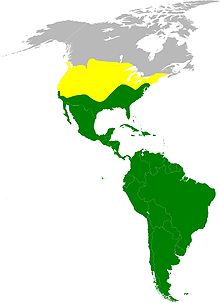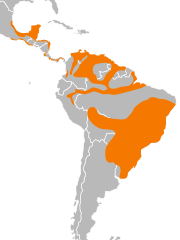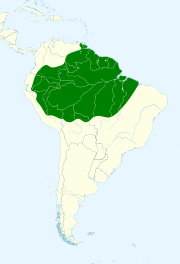Cathartes
| Cathartes | |
|---|---|

| |
| Turkey vulture in Morro Bay , California
| |
| Scientific classification | |
| Domain: | Eukaryota |
| Kingdom: | Animalia |
| Phylum: | Chordata |
| Class: | Aves |
| Order: | Cathartiformes |
| Family: | Cathartidae |
| Genus: | Cathartes Illiger, 1811 |
| Type species | |
| Vultur aura[1][2] Linnaeus, 1758
| |
| Species | |
| |

| |
| Approximate distribution of the genus Cathartes. Green indicates that at least one species is resident year-round and yellow shows areas where one species, the turkey vulture, is a summer-only breeding visitor. | |
The genus Cathartes includes medium-sized to large carrion-feeding birds in the New World vulture (Cathartidae) family. The three extant species currently classified in this genus occur widely in the Americas. There is one extinct species known from the Quaternary of Cuba.[3]
Cathartes is the Greek word καθαρτής, for "purifier," referring to these vultures' role as "cleansers" that "tidy up" decomposing corpses in nature.
Taxonomy
Description
The first member of this genus to be formally described, the turkey vulture, was named by Linnaeus as Vultur aura in his Systema Naturae in 1758,[4] but was eventually moved to the current genus which had been created by German zoologist Johann Illiger in 1811.[5] The yellow-headed birds first described in 1845 by John Cassin were not split into two species until 1964.[6][7]
Systematics
Cathartes is one of the five genera of
In 2007 the
Species
The genus Cathartes has three recognized extant species:[15][3]
| Common name | Scientific name and subspecies | Range | Size and ecology | IUCN status and estimated population |
|---|---|---|---|---|
| Turkey vulture | Cathartes aura (Linnaeus, 1758) Five subspecies
|
the Americas from southern Canada to Cape Horn
|
Size: Habitat: Diet: |
LC
|
| Lesser yellow-headed vulture | Cathartes burrovianus Cassin, 1845 |
Argentina, Belize, Bolivia, Brazil, Chile, Colombia, Costa Rica, Ecuador, El Salvador, French Guiana, Guatemala, Guyana, Honduras, Mexico, Nicaragua, Panama, Paraguay, Peru, Suriname, Uruguay, and Venezuela
|
Size: Habitat: Diet: |
LC
|
| Greater yellow-headed vulture | Cathartes melambrotus Wetmore, 1964 |
South America
|
Size: Habitat: Diet: |
LC
|
One
Description
All Cathartes species have featherless heads with brightly colored skin, yellow to orange in the yellow-headed vultures, bright red in the turkey vulture. All three species share a well-developed sense of smell, which is rare in birds, that enables them to locate carrion under the canopy.
Distribution and habitat
The vultures of Cathartes mosty occupy forests of the Americas, especially Mexico, Central America, and South America.
Ecology and behaviour
While all species obtain most of their diet by scavenging, the lesser yellow-headed vulture is known to hunt live prey in wetland environments.
References
- ^ Vigors, N. A. (1825). "Sketches in Ornithology; or, Observations on the leading Affinities of some of the more extensive groups of Birds. On the Groups of the Vulturidæ". The Zoological Journal. 2 (7): 384.
- ^ International Commission on Zoological Nomenclature (1958) [1916]. "Opinion 67. One Hundred and Two Bird Names Placed in the Official List of Generic Names". Opinions and Declarations Rendered by the International Commission on Zoological Nomenclature. 1 (B): 177–182.
- ^ ISSN 0007-1595.
- ^ Linnaeus, Carolus (1758). Systema naturae per regna tria naturae, secundum classes, ordines, genera, species, cum characteribus, differentiis, synonymis, locis. Tomus I. Editio decima, reformata (in Latin). Holmiae. (Laurentii Salvii). p. 86.
- ^ Illiger, Johann (1811). Prodromus systematis mammalium et avium. Berolini: Sumptibus C. Salfeld. p. 236.
- ^ Cassin, John. "[untitled]". Proceedings of the Academy of Natural Sciences of Philadelphia. 2 (8): 212.
Near Veracruz, Mexico.
- ^ Wetmore, Alexander (1964). "A revision of the American vultures of the genus Cathartes". Smithsonian Miscellaneous Collections. 146 (6): 15.
- ^ Remsen, J. V. Jr.; C. D. Cadena; A. Jaramillo; M. Nores; J. F. Pacheco; M. B. Robbins; T. S. Schulenberg; F. G. Stiles; D. F. Stotz & K. J. Zimmer (2007) A classification of the bird species of South America. Archived March 2, 2009, at the Wayback Machine South American Classification Committee]
- ISBN 0-300-04969-2
- ^ American Ornithologists' Union (2009)
- ^ Remsen et al. (2008)
- ^ Hackett et al. (2008)
- ^ American Ornithologists' Union (2010)
- International Ornithological Congress. "IOC World Bird List". 14.1. IOC. Retrieved 25 January 2024.
- ^ "Cathartes". Integrated Taxonomic Information System. Retrieved 15 May 2011.
- ^ Sauer, J. R., J. E. Hines, J. E. Fallon, K. L. Pardieck Jr. Ziolkowski, D. J. and W. A. Link. The North American Breeding Bird Survey, results and analysis 1966-2013 (Version 1.30.15). USGS Patuxent Wildlife Research Center (2014b). Available from http://www.mbr-pwrc.usgs.gov/bbs/ Archived 2012-06-09 at the Wayback Machine
- .
- ^ BirdLife International (2024). "Greater Yellow-headed Vulture Cathartes melambrotus". BLI Datazone.
- ISSN 0007-1595.



